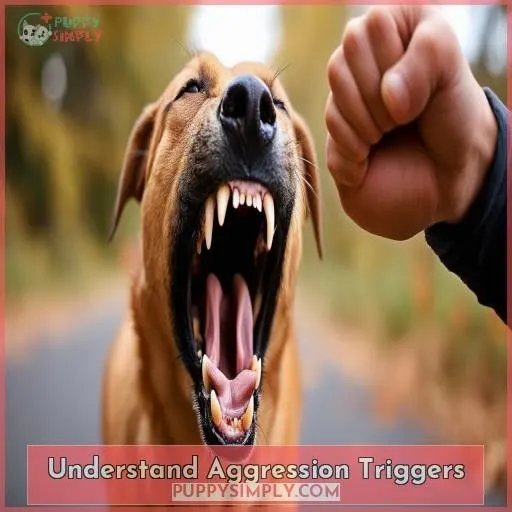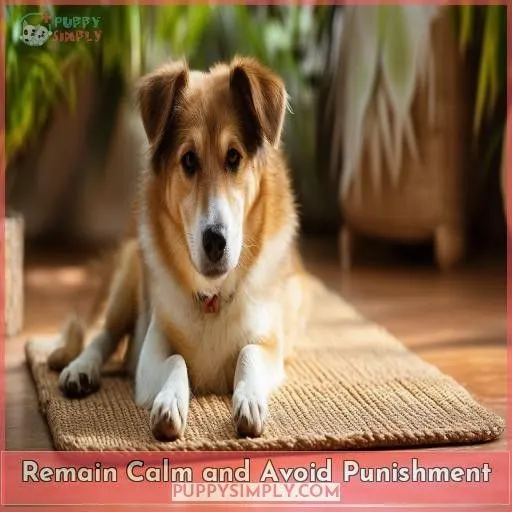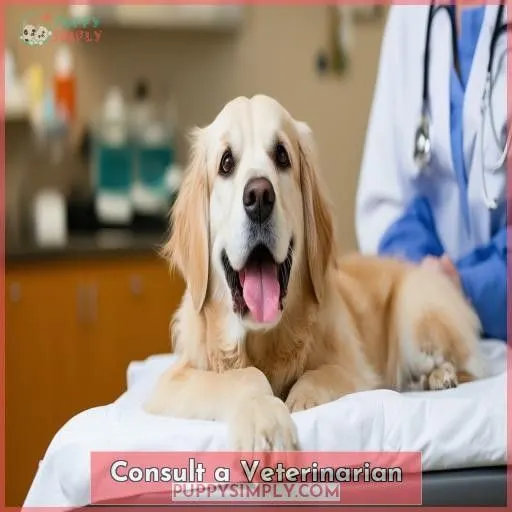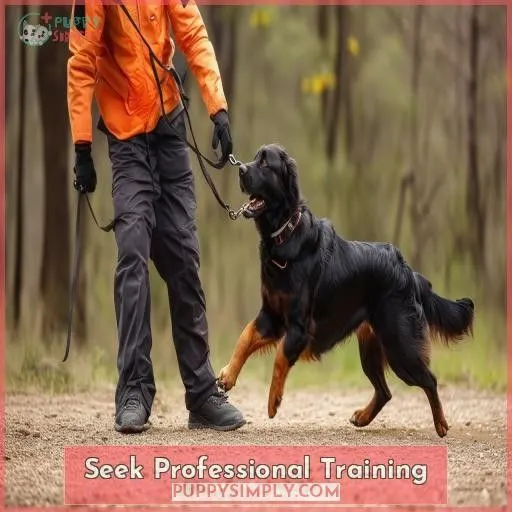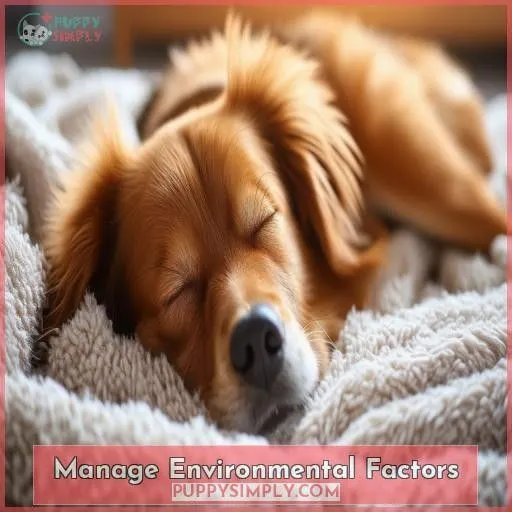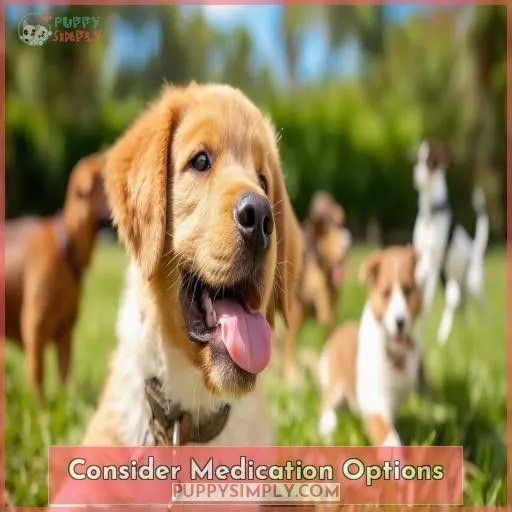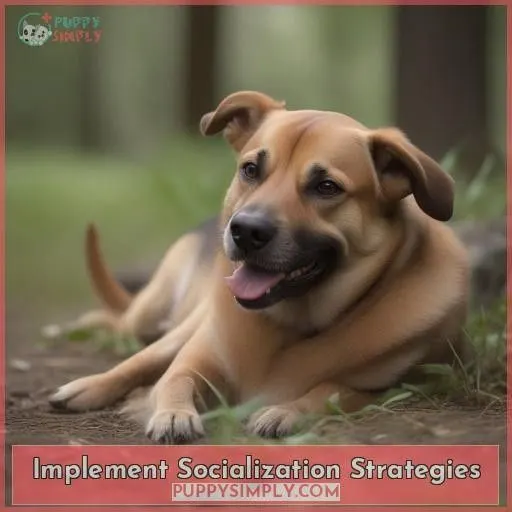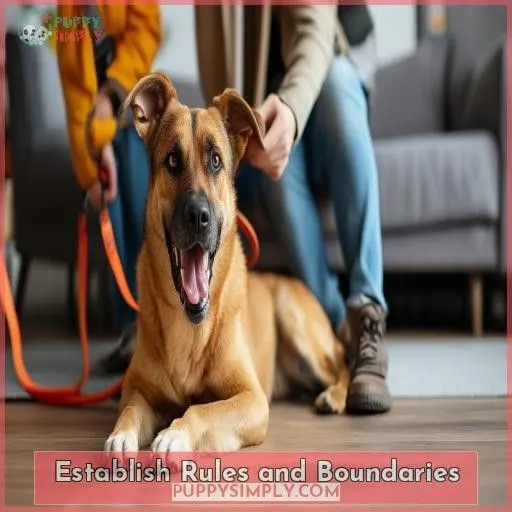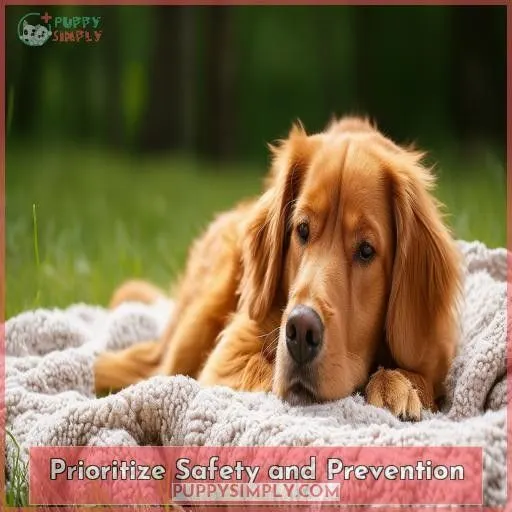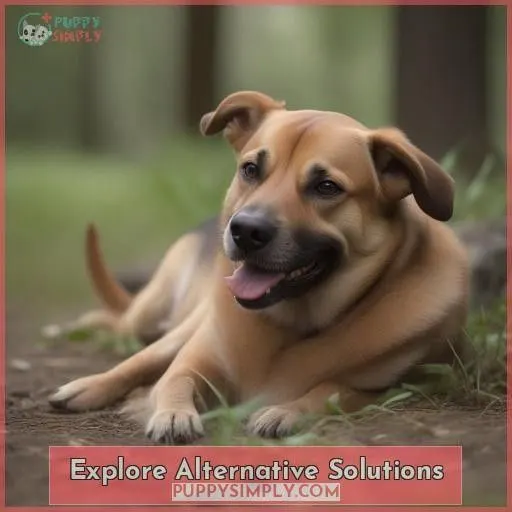This site is supported by our readers. We may earn a commission, at no cost to you, if you purchase through links.
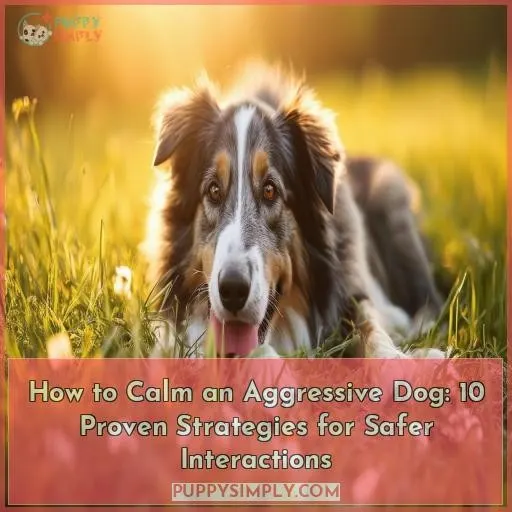
First, identify potential triggers like loud noises or unfamiliar people, and avoid high-risk situations.
When faced with aggression, remain calm, avoid direct eye contact, and slowly create distance.
Consult a vet to rule out medical issues contributing to the behavior.
Seek professional training that utilizes positive reinforcement, desensitization, and obedience techniques.
Provide a secure, low-stress environment with safe spaces for retreat.
With consistent management strategies and by prioritizing safety, you can help reduce aggression triggers and foster a calmer dynamic.
Want to explore more proven methods? Read on for a thorough breakdown.
Table Of Contents
- Key Takeaways
- How to Calm an Aggressive Dog?
- Understand Aggression Triggers
- Remain Calm and Avoid Punishment
- Consult a Veterinarian
- Seek Professional Training
- Manage Environmental Factors
- Consider Medication Options
- Implement Socialization Strategies
- Establish Rules and Boundaries
- Prioritize Safety and Prevention
- Explore Alternative Solutions
- Frequently Asked Questions (FAQs)
- How do you get a dog to stop being aggressive?
- How should I react when my dog is aggressive?
- Can an aggressive dog be treated?
- What to do with an aggressive dog that bites you?
- How to identify the type of aggression?
- What training methods are most effective?
- When is it time to rehome an aggressive dog?
- Are certain breeds more prone to aggression?
- How to introduce an aggressive dog to new environments?
- Conclusion
Key Takeaways
- Patience is the name of the game when dealing with an aggressive pup. Rome wasn’t built in a day, and neither is a calm canine companion. Buckle up and embrace the journey!
- Identifying and avoiding those pesky triggers is crucial. It’s like playing a game of "hot and cold" – steer clear of the "hot" situations that set Fido off until you’ve got a handle on things.
- Positive reinforcement is your best friend. Treats, praise, and lots of love go a long way in shaping good behavior. Think of it as a delicious trail of breadcrumbs leading your furry pal down the right path.
- Safety first, always. Whether it’s muzzle training, secure spaces, or seeking professional guidance, prioritize keeping everyone (two-legged and four-legged alike) out of harm’s way. It’s like having a trusty life jacket on a rowboat – you hope you never need it, but it’s reassuring to have it just in case.
How to Calm an Aggressive Dog?
To calm an aggressive dog, remain calm yourself and avoid punishing the dog, as this can escalate aggression. Consult a professional trainer or veterinarian to develop positive reinforcement techniques and identify potential triggers.
Understand Aggression Triggers
Understanding what triggers your dog’s aggression is essential for managing their behavior.
Aggression often stems from fear, protectiveness, or a perceived threat.
Pay attention to your dog’s body language—growling, stiff posture, and dilated pupils signal discomfort.
Identify potential triggers like unfamiliar people, loud noises, or invading their space.
Avoid high-risk situations until you can address the root cause.
Socialization from an early age helps prevent fear-based aggression by exposing your pup to new experiences positively.
With patience and consistency, you can learn to recognize the signs and modify the environment to minimize triggers and keep everyone safe.
Remain Calm and Avoid Punishment
It’s essential to remain calm when dealing with an aggressive dog. Any agitation or punishment can escalate the situation, as dogs are highly perceptive to body language and tone.
Take a deep breath, avoid direct eye contact, and slowly create distance.
Identify potential triggers contributing to the aggression, like territoriality or fear, so you can de-escalate appropriately.
early socialization and positive reinforcement training are key to preventing aggressive behavior.
But if aggression persists, seek guidance from a professional trainer skilled in interpreting canine body language and implementing desensitization techniques to modify the dog’s response safely, without compromising your personal safety.
Consult a Veterinarian
Before addressing an aggressive dog’s behavior, consult a veterinarian to rule out underlying medical conditions. Aggression can stem from:
- Pain or illness
- Neurological disorders
- Hormonal imbalances
Your vet can perform diagnostic tests and behavioral assessments to identify potential causes. They may recommend:
- Medication to manage pain or anxiety
- Treatment for any diagnosed conditions
- Referrals to animal behaviorists
It’s important to involve your vet, as they can provide valuable insights into your dog’s specific situation and advise on the safest approach. With their expertise, you can better understand the root cause and develop an effective plan specific to your furry friend’s needs.
Seek Professional Training
One of the most effective ways to address aggressive behavior in dogs is through professional training that utilizes positive reinforcement techniques. Certified trainers can guide you in methods like desensitization, counter-conditioning, and obedience training to help your dog remain calm and focused in triggering situations.
Positive Reinforcement Techniques
Seek professional guidance on positive reinforcement techniques that reward desired behaviors. This approach conditions your dog to associate calm responses with treats or praise, gradually modifying aggressive tendencies through consistent training and obedience.
Desensitization and Counter-Conditioning
To address aggression, gradually expose your dog to triggers while rewarding calm behavior – a process called desensitization and counterconditioning. Seek guidance from professionals to implement this safely and manage issues like resource guarding or control aggression that could otherwise lead to bites and lawsuits.
Obedience Training
Obedience training builds a foundation for communication and control. It teaches your dog:
- Basic commands like sit, stay, and heel
- Impulse control and focus
- Socialization with distractions
- Respect for boundaries
When combined with positive reinforcement, it helps modify aggressive behaviors.
Manage Environmental Factors
To effectively manage an aggressive dog’s environment, you should seek to avoid situations that may trigger their aggression, such as keeping them away from stressors like loud noises or unfamiliar people and animals. Additionally, provide your dog with a safe, secure space where they can retreat and feel comfortable, gradually introducing changes to minimize anxiety and reactive behavior.
Avoid Triggering Situations
With professional guidance, identify and avoid situations that trigger your dog’s aggression. Managing fear through gradual, reward-based exposure requires patience and consistency. Recognize high-risk scenarios early to prevent escalation safely.
Provide Safe Spaces
Along with avoiding triggers, create a secure "safe zone" for your dog—a quiet corner or crate with calming aids like toys and bedding. This cozy den area provides relief during stressful situations, preventing aggressive outbursts.
Introduce Changes Gradually
Once safe spaces are set up, gradually expose your dog to triggers in a controlled environment. Identify what sets them off, then slowly increase proximity while rewarding calm behavior. Manage their environment by making thoughtful, gradual changes to help them feel secure.
Consider Medication Options
In some cases, your veterinarian may recommend anti-anxiety medications or behavior-modifying drugs to help calm an aggressive dog and make training more effective. These medications should only be used under veterinary guidance as part of a thorough treatment plan that also addresses the underlying causes of the aggression.
Anti-Anxiety Medications
If your vet recommends it, anti-anxiety medications can make calming training sessions more effective. Don’t rely solely on meds, though – their effects are temporary. Work closely with your vet to find the right dosage and monitor for potential side effects like sedation or appetite changes. Long-term medication may be necessary for severe cases.
Behavior-Modifying Drugs
For more severe cases, your vet may recommend behavior-modifying drugs. These can help reduce aggression, but require close monitoring for side effects and interactions. Discuss potential long-term effects and explore alternative therapies like counter-conditioning. Medication is a tool, not a cure-all, so pair it with training for best results under your vet’s guidance.
Implement Socialization Strategies
Gradually expose your dog to situations that trigger aggression, starting at a distance or intensity level that doesn’t provoke a reaction. As your dog remains calm, reward this behavior with treats and praise, creating a positive association with the trigger.
Controlled Exposure to Triggers
After consulting medication options, gradually expose your dog to triggers in a controlled, safe environment. Start at a distance where they remain calm using: 1) Barriers for safety 2) Short sessions for success 3) Distractions like treats 4) Slow, incremental progress. Proper desensitization therapy avoids reinforcing fear – a gradual approach is key.
Reward Calm Behavior
You’ll also want to consistently reward calm behavior around triggers with treats and praise. This positive reinforcement helps reinforce the desensitization process. Incorporate socialization exercises like teaching obedience commands in low-stress environments. As your dog masters counter-conditioning methods, gradually increase exposure while praising calmness. Stay patient—progress takes time.
Establish Rules and Boundaries
Establishing clear rules and boundaries is essential for managing an aggressive dog’s behavior. By consistently enforcing limits, you teach your dog what’s acceptable and what isn’t. Here are some key points:
- Set well-defined rules (no begging, no jumping, etc.) and uphold them
- Use positive reinforcement to reward calm, submissive behavior
- Find a support group for owners dealing with aggression issues
- Be aware of breed-specific tendencies and intervene early if aggression arises
Involving the whole family guarantees everyone is on the same page. Consistency is key – mixed signals will only confuse and frustrate your dog. With patience and diligence, you can curb aggressive tendencies before they escalate into more serious consequences.
Prioritize Safety and Prevention
When dealing with an aggressive dog, muzzle training can be an essential safety measure to prevent bites and injuries. Secure containment, such as crates or pens, also helps to avoid escalation by providing a safe space for the dog and limiting exposure to potential triggers.
Muzzle Training
You should also consider muzzle training for safety. Properly fitted muzzles prevent biting but allow panting and drinking. Introduce the muzzle gradually with positive reinforcement to build acceptance. While uncomfortable, a safe muzzle is key when aggression can’t be avoided.
Secure Containment
Providing safe spaces is essential for aggressive dogs. You’ll want to:
- Invest in secure crates or kennels
- Establish dog-proofed rooms or areas
- Use baby gates to restrict access
Gradually introducing changes can also help ease anxiety. Secure containment allows for controlled exposure while ensuring everyone’s safety.
Avoid Escalation
Don’t make sudden movements or loud noises that could further agitate your dog. Establish clear boundaries while desensitizing them to triggers through gradual exposure and positive reinforcement. Consider medication if their aggression stems from anxiety. Prioritize safety by avoiding risky situations until their behavior stabilizes.
Explore Alternative Solutions
If calming strategies and professional training don’t sufficiently address your dog’s aggression, you may need to explore alternative solutions. Consulting a certified animal behaviorist or considering rehoming your dog with a rescue organization equipped to handle aggression cases could be necessary steps for ensuring everyone’s safety and providing your dog with the appropriate environment.
Rehoming Considerations
If aggression can’t be managed safely, consider rehoming as an ethical last resort. Thoroughly evaluate your dog’s temperament and legal obligations. Prioritize everyone’s safety, as difficult as this decision may be.
Consulting Behavior Specialists
If training and medications don’t help, consult a veterinary behaviorist. They’ll assess underlying causes, recommend behavioral therapy, and explore options – from managing medical issues to rehoming for an ideal environment.
Lifestyle Adjustments
You might need to adjust your dog’s daily routine, home environment, exercise schedule, and socialization opportunities to avoid triggers and manage their aggression effectively. Avoiding high-stress situations and providing a calm, consistent lifestyle can greatly improve their behavior.
Frequently Asked Questions (FAQs)
How do you get a dog to stop being aggressive?
To stop dog aggression, identify triggers, use positive reinforcement training with treats or praise. Avoid punishing the behavior, which can worsen aggression. Consult a professional dog trainer if aggression persists.
How should I react when my dog is aggressive?
When confronted with aggression, remain calm. Avoid staring directly at your dog or sudden movements. Disengage by walking away until the dog settles down. Consult a professional trainer or behaviorist for guidance on resolving the underlying causes.
Can an aggressive dog be treated?
With patience and professional help, absolutely – aggressive dogs can overcome their issues. Through specialized training, behavior modification, and sometimes medication, many aggressive pups blossom into well-adjusted companions. Don’t give up – a calm, happy dog awaits with the right approach.
What to do with an aggressive dog that bites you?
If an aggressive dog bites you, immediately remove yourself from the situation. Seek medical attention for any wounds and contact animal control. Avoid confrontation, which could escalate the aggression. A professional behaviorist can assess the dog’s behavior and recommend next steps.
How to identify the type of aggression?
Observe your dog’s behavior closely for signs like growling, snarling, or stiffening their body. These cues can indicate fear-based, territorial, or resource guarding aggression. Pay attention to triggers to identify the type accurately.
What training methods are most effective?
Positive reinforcement training is most effective for addressing dog aggression. Reward desired calm behaviors gradually, avoiding punishment. With patience and consistency, your dog will learn appropriate responses to triggers.
When is it time to rehome an aggressive dog?
An avalanche of aggression signals it’s time to rehome: seek professional guidance first, but if dangers persist despite training, a new loving home may provide a safer environment.
Are certain breeds more prone to aggression?
Some breeds were historically bred for protective or working roles, which can contribute to potential aggression if not appropriately trained and socialized. However, each dog is an individual, and proper upbringing and training are essential for managing behavior across all breeds.
How to introduce an aggressive dog to new environments?
To introduce an aggressive dog safely, go slowly. Acclimatize them first to neutral spaces without triggers. Reward calm behavior, and leave if tension escalates. Seek professional guidance for complex cases. The well-being of all is paramount.
Conclusion
By cultivating patience and implementing proven strategies like avoiding triggers, professional training, socialization, boundary-setting, and prioritizing safety, you can navigate the challenges of calming an aggressive dog. Though the road may be winding, persevering with evidence-based methods under expert guidance offers the prospect of fostering a more harmonious dynamic and nurturing a calmer, better-behaved canine companion.

